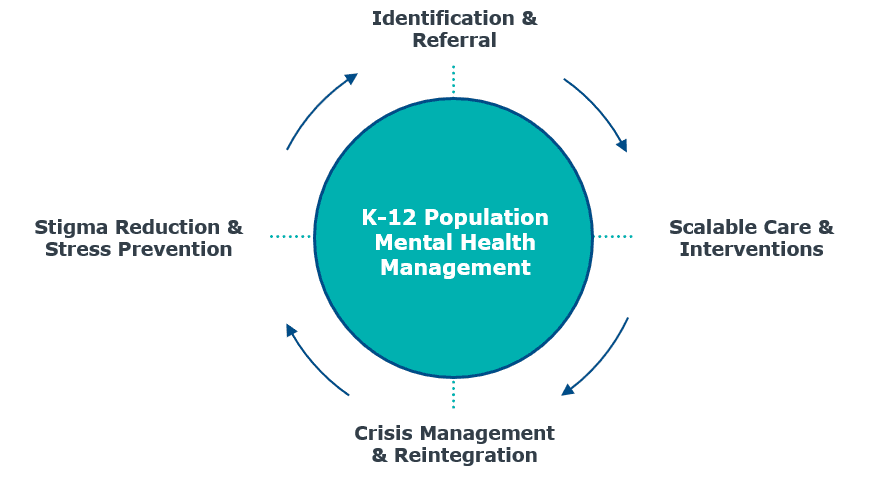Guide for Mental Health Management in K-12 Schools
This guide provides district teams with a structured approach for improving mental health supports in schools.
Even prior to the outbreak of COVID-19 and the current political climate, rates of anxiety, depression, and suicide among children and teens have been steadily rising at alarming rates. As a result, district leaders are expecting to see a continued surge in the number of students requiring additional support for their mental health.
This guide from the District Leadership Forum provides district teams with a structured approach for school-based mental health supports. The 10 strategies outlined form the foundations of a “population health management” model that will improve outcomes for students and reduce strain on district staff and resources.

Stage 1: Identify students in need of additional mental health support
Universal screening
Universal screeners for psychological and behavioral health consist of a series of questions to be answered by the student (if old enough), their parent(s), and their teacher(s). There are several evidence-based screeners available, and districts should select the instrument that best fits their district’s needs.
Adult-student relationship mapping
Adult-student relationship mapping is a simple, “no cost” practice that enables schools to systematically ensure that every child in their building has a strong connection with at least one member of staff. Staff are asked to answer five yes/no questions about students in the grade levels they work with. Following each mapping, plans should be made to connect with students who may be at risk of receiving less attention and feeling less included.
First responder "Handle with Care" notifications
‘Handle with Care’ is an initiative that alerts schools when a student is involved in (or witnesses) a potentially traumatic incident in the community. First responders send a simple notification to the district with no incident details (FERPA compliant), enabling school staff to monitor that student more closely over the following days and weeks.
Behavioral health intervention teams
Behavioral Health Intervention Teams (BHITs) are cross-functional teams of administrators, support staff, and clinicians who leverage collective knowledge to identify appropriate supports for students and efficiently refer them to services. They also identify and monitor patterns in student needs and behaviors and then use that information to optimize preventative programming and primary care.
Stage 2: Ensure students have access to evidence-based interventions and clinical care
Group cognitive behavioral therapy
Cognitive Behavioral Therapy (CBT) has been described as the “gold standard” for reducing moderate to severe symptoms of anxiety and depression. While often administered as an individual treatment, CBT has also been proven to be highly effective in group settings.
Tele-mental health care
All forms of tele-health enable populations to receive crucial clinical care without traveling to a clinic or provider site. Students and staff can connect services from a dedicated room within their school or while learning/working from home through a district-facilitated partnership with a local provider.
Stage 3: Coordinate crisis management from referral to reentry
Designated crisis referral coordinator
Crisis referral coordinators support students and their families all the way from initial referral to completion of treatment and successful return to the classroom. They work with parents to overcome logistical barriers, check-in to monitor progress, and coordinate a structured reentry program for each student.
Coordinated student reentry process
A structured, gradual reentry process provides students with a manageable return to learning and socializing for students who have experienced a mental health related crisis. The process requires a dedicated space, support staff, and clear plan developed in conjunction with the student’s family.
Stage 4: Reduce stigma and increase engagement in preventative practices
Data-informed social and emotional learning
A data-informed strategy for social and emotional learning (SEL) programming leverages insights from universal screening, patterns in school referrals, and insights from district clinical partners to select Tier I and II interventions and curricula that best fit your students’ needs.
Responsive family education surveys and programs
Best-in-class family education programs gather and leverage input from families, teachers, and community leaders to identify the topics that will attract attendance and best serve family needs. Survey-driven programming has proven to be even more successful and necessary since events moved to the virtual environment in March.
This resource requires EAB partnership access to view.
Access the tool
Learn how you can get access to this resource as well as hands-on support from our experts through District Leadership Forum.
Learn More